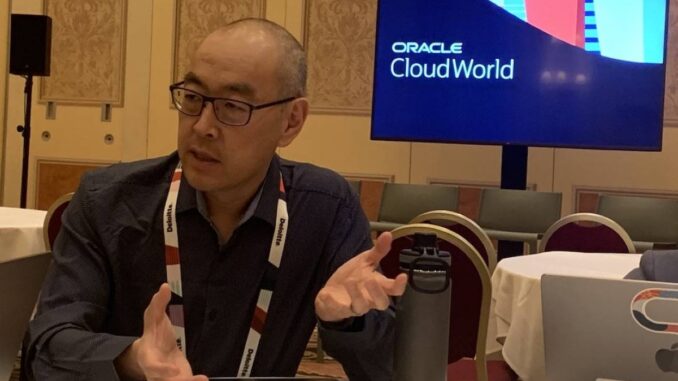
AT the recent Oracle CloudWorld 2024, the enigmatic Larry Ellison, founder, chairman and chief technology officer of tech giant Oracle, has declared the beginning of the open multi-cloud era.
Saying that the “time has come for the largest cloud infrastructure providers to gracefully open and integrate their systems.”
For his part, Leo Leung, vice president of product marketing at Oracle Cloud Infrastructure (OCI), shared insights about the company’s growing cloud business, particularly in the post-pandemic era, in a roundtable with media from the Asian region.
Leo Leung, vice president, product marketing, Oracle Cloud Infrastructure (OCI), shared insights about the company’s cloud business in a roundtable with media from the Asian region at Cloudworld 2024 in Las Vegas, Nevada. PHOTO by JING GARCIA
“During the pandemic, we saw an acceleration in cloud business,” said Leung. “Many companies had to transform their operations, especially retail businesses, which had to handle lots of online orders and pickup services. The restaurant industry in many countries also had to change. This forced many companies to evolve their IT infrastructure, and a lot of them chose the cloud.”
“Coming out of the pandemic, AI adoption has increased significantly, adding to the work companies are doing to digitize their infrastructure. As you can see from our results at Oracle, we’ve had very strong growth over the last few years,” he added.
From a cloud perspective, as Ellison said in his keynote, Oracle has started partnering with other cloud providers like Amazon Web Services and Microsoft. The tech giant also recently announced the general availability of Oracle Database on Google Cloud. With this strategic move, all the major hyperscalers are now Oracle partners.
“We compete, but we also collaborate to provide customers with the best options,” said Leung. “On the service provider side, a big part of our strategy is a product called Oracle Alloy, which lets us deploy OCI on behalf of a customer wherever they need it.”
“This approach lets partners deploy cloud solutions in specific regions and industries, allowing them to reach customers more effectively than we can alone. Our role is to provide the technology while they handle customer relationships,” Leung said.
Oracle is learning how different markets behave, said the executive. In Japan, for example, IT purchases are often controlled by large integrators like Fujitsu, so Alloy allows the company to tap into that market. “In other parts of Asia, it’s different, but we’re adapting to each region,” said Leung.
Huge opportunity in AI
“It’s not just about consumer-generative AI; it’s about using proprietary data to make AI better for specific industries,” said Leung. “This requires collaboration between us, technology partners, and service providers. There’s a lot of potential to help customers develop AI solutions tailored to their needs.”
Oracle’s goal, according to Leung, is to support businesses internally or with their customers by providing top-notch AI infrastructure. “Our Alloy and AI stack offer solutions to our customers’ clients. This makes it easier for companies to adopt AI without having to manage the underlying technology.”
With so many AI products, the market is getting confusing. There are so many large language models out there, and customers need guidance to choose the right tools. Part of Oracle’s role is to curate and validate these technologies to make things easier for them.
“While generative AI is getting a lot of attention, machine learning continues to play a key role in everyday business operations,” said Leung. “We’re investing across the board, whether it’s document understanding or image recognition. Our strategy is to make these capabilities easily available through our SaaS offerings.
On prem
On-prem or on-premise is still a big part of Oracle’s business, according to Leung. “In fact, 50-70 percent makes up the infrastructure spending depending on the analyst you ask. Many businesses are still on-prem because they need low-latency access to applications, or they have strict data sovereignty requirements, like in New Zealand or the Philippines.”
For customers who can’t move to the public cloud, Oracle offers dedicated regions or deploy OCI inside the data centers. This, in turn, allows customers to have a private cloud with all the capabilities of a public cloud but within their own infrastructure.
“For smaller companies, we offer a range of solutions, from using our technology stack to self-service models where they can purchase services directly with a credit card,” said Leung. “Some startups are very sophisticated and use our infrastructure to build their own applications, while others rely more on our full-stack solutions like NetSuite.”


Be the first to comment